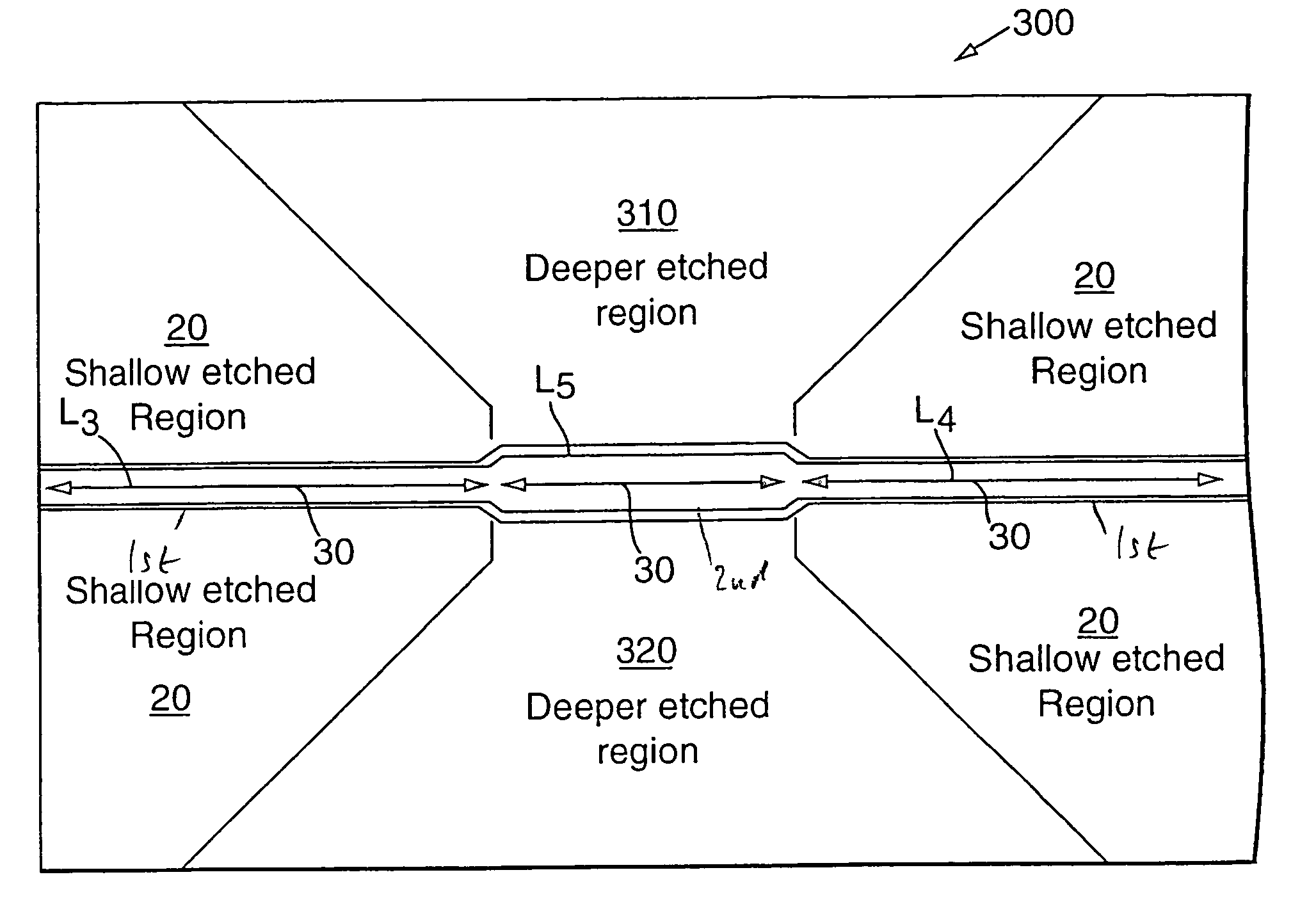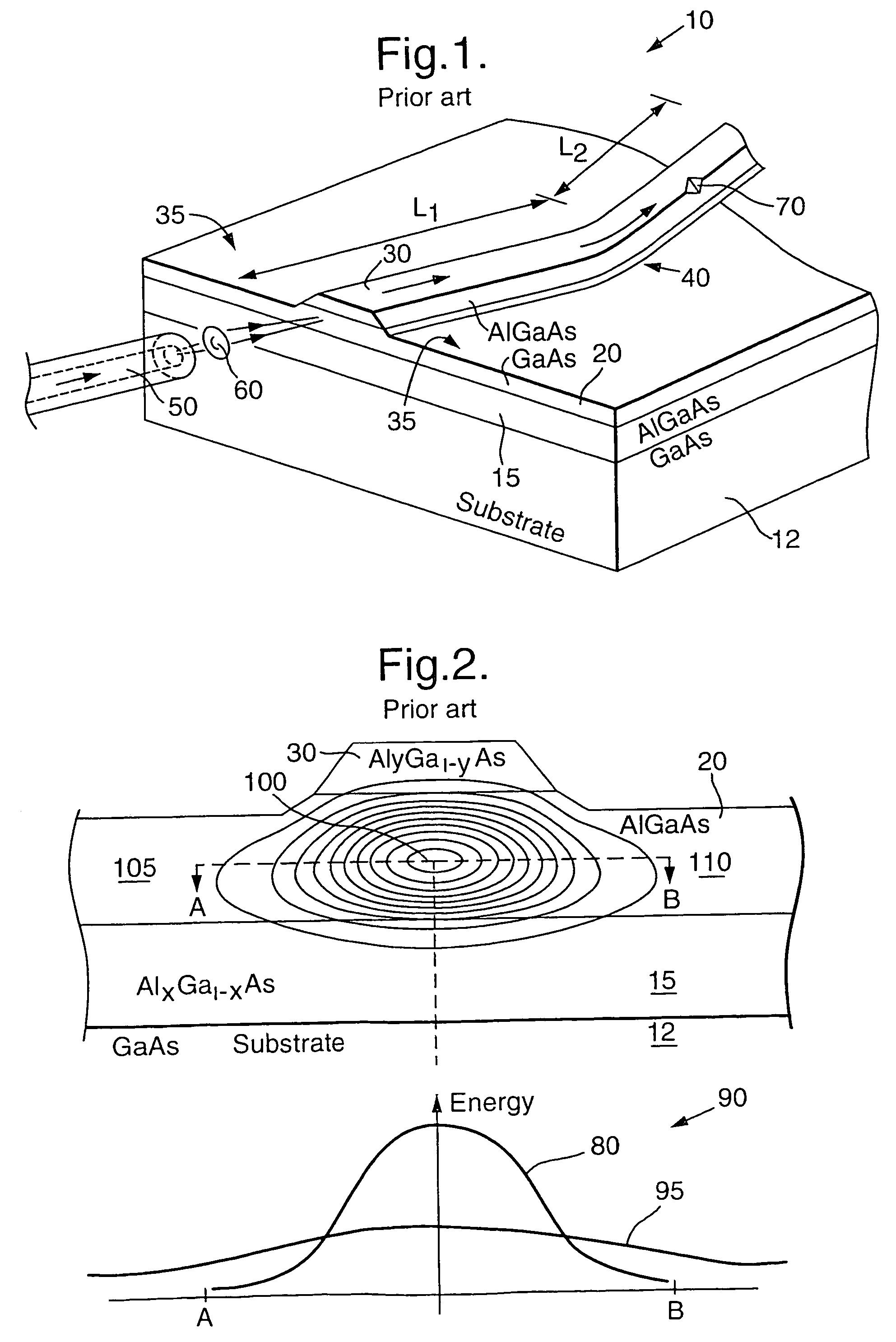Guided wave spatial filter
a spatial filter and waveguide technology, applied in the direction of optical waveguide light guide, instruments, optics, etc., can solve the problems of quasi-chaotic perturbation of circuit characteristics, and achieve the effects of enhancing the extinction ratio, hindering the propagation and preventing the coupling of higher-order mode radiation
- Summary
- Abstract
- Description
- Claims
- Application Information
AI Technical Summary
Benefits of technology
Problems solved by technology
Method used
Image
Examples
first embodiment
[0081]Referring now to FIG. 3, there is shown in plan view a pin-hole type guided wave spatial filter according to the invention. The pin-hole filter is indicated generally by 200 and includes the substrate 12, the lower substrate layer 15, the upper substrate layer 20, the rib waveguide 30 and two deeper etch regions 210, 220 etched symmetrically about the waveguide 30 but not encroaching thereonto; regions of shallower etching 230, 240 separate the waveguide 30 from the deeper etch regions 210, 220. The deeper regions 210, 220 each assume the form of a triangular area having a corner thereof orientated to point towards the waveguide 30 as illustrated in FIG. 3, each corner is at a distance of 10 μm from its nearest peripheral wall of the waveguide 30. The comers are mutually separated by a distance of substantially 23 μm.
[0082]In FIG. 3, there is also shown a cross-sectional view of the filter 200 along an axis C–D, the view indicated generally by 250.
[0083]When fabricating the fi...
second embodiment
[0097]The inventor has therefore devised an alternative design of spatial filter according to the invention which addresses the performance limitations of the filter 200 as well as technical difficulties associated with its fabrication. Referring to FIG. 4, there is shown in plan view an in-line type guided wave spatial filter according to the invention, the in-line guided wave filter indicated generally by 300. The filter 300 comprises the waveguide 30 flanked along its length in sections L3, L4 thereof by the upper substrate layer 20 which has been shallowly etched back so that an upper surface of the waveguide remotest from the layer 20 projects 1 μm above the layer 20 in a similar manner as in the integrated circuit 10. The filter 300 additionally comprises a central section L5 situated between the section L3, L4 where the waveguide 30 is flanked by deeper etch regions 310, 320 at both sides thereof These deeper regions 310, 320 both taper outwardly away from the waveguide 30; a...
third embodiment
[0111]Variants of the spatial filter 300 in FIG. 5 can be fabricated in conjunction with other types of optical structures, for example FIG. 8 is an illustration of a multimode interference splitter indicated generally by 800, the splitter 800 comprising a guided wave spatial filter indicated by 810 according to the invention incorporated at an optical input port of the splitter 800.
[0112]In comparison to the splitter 800, a conventional multimode splitter comprises an optical input port coupled to a multimode mixing region including a plurality of optical output ports. The input and output ports are coupled to waveguides for guiding optical radiation to and from the mixing region. Fundamental mode input radiation is applied through a waveguide associated with the input port to the mixing region and excites a multiplicity of radiation modes in the region. The output ports are judicially positioned where the multiplicity of modes mutually sum to provide energy maxima. As a consequenc...
PUM
| Property | Measurement | Unit |
|---|---|---|
| free-space wavelength | aaaaa | aaaaa |
| height | aaaaa | aaaaa |
| height | aaaaa | aaaaa |
Abstract
Description
Claims
Application Information
 Login to View More
Login to View More - R&D
- Intellectual Property
- Life Sciences
- Materials
- Tech Scout
- Unparalleled Data Quality
- Higher Quality Content
- 60% Fewer Hallucinations
Browse by: Latest US Patents, China's latest patents, Technical Efficacy Thesaurus, Application Domain, Technology Topic, Popular Technical Reports.
© 2025 PatSnap. All rights reserved.Legal|Privacy policy|Modern Slavery Act Transparency Statement|Sitemap|About US| Contact US: help@patsnap.com



